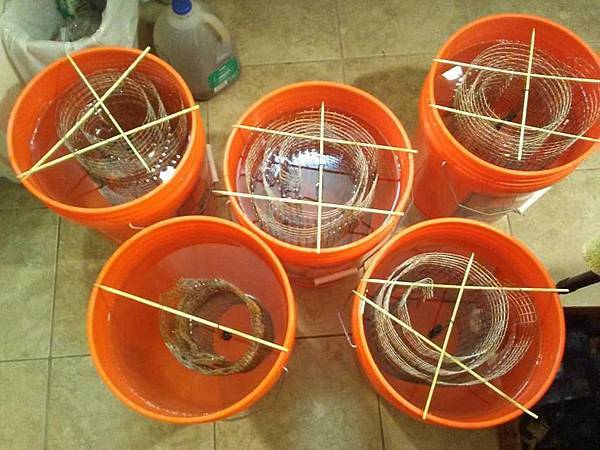CH甘斯
用氫氧化鈉奈米塗層的銅
鍍鋅鐵絲網,奈米塗層過的鐵,有鋅的殘留,有助於碳的場域(CH3裡頭的C)。
我們不用銅線、LED、或電線、用竹棍仍能轉移能量,但有電阻。竹棍燒過後在靠近等離子體時更具傳導功能,在這個實作裡,我沒有燒竹棍,以便在奈米銅與奈米鐵絲網之間,保持較高的電阻。

=========
補充說明
=========
回應一(來自馬克)
1公升水對35~40g的鹽,(不管選什麼鹽),這個比例,約為海水的鹽度,整個收成過程都保持這樣的鹽度。你可以自己試試,不同大小的奈米(塗層)銅,去體驗出來的結果會有何不同。
選擇性可以是奈米銅線、奈米髒魯啊(家裡清潔用的)、奈米銅板

回應二(來自賈斯汀)
馬克講的是對的,你要自己試試看,才會知道怎樣的材料出來怎樣的結果。奈米塗層過程中,物料表面的奈米塗層區域會增加。有時這些奈米分層會到將近9萬的分層。如果你的奈米塗層品質很好,相較於急就章,維持的效果會差很多。

用鐵生成CH3甘斯,只需很少的鹽。
因為鐵非常具有給予的特性,所以鹽使用的比例上會有差異。
如果我用五個5加侖(18.9公升)的桶子,
剛開始我會先在其中一桶加將近1kg的鹽,連同水,混成5加侖的容量。
拿出1加侖,分裝到這五個桶子。
所以最開始的1kg的鹽,五個桶子合用。(很稀釋)
鐵非常給予,如果鹽又太濃,或阻力太低,
甘斯生成會有太多鐵質,我們想避免
處理碰撞過程,所有甘斯會滑落。我想要加速生成,所以24小時後,把它們取出,讓它們一夜生鏽,早上再度放回鹽水裡。這是我加速大量生成CH3的方式,我會做這個好幾個禮拜。好處之一,生成的甘斯裡頭,找不到太多物質的東西。
25加侖,通常在一個月的生成中,可產生3加侖的CH3

CH3 GaNS
Zero Boost CH3
From Caustic Nanocoated Copper & Galvanized Chicken Mesh ( left over mesh from using Armens Method found on youtube is now nanocoated iron that has trace elements of zinc which help facilitate the carbon field in the "C" of "CH3". In the zero boost we don't use wires, LEDs or electricity. The bamboo stick still carries a transfer of energy but is very resistive and can even be charred for more conductive properties that are near Plasmatic. In this case I'm not burning the bamboo to keep a higher resistance between the nanocoated copper and nanocoated chicken wire.
=========
Remarks:
=========
Comment 1 from Mark House
Make a tub of good (per liter) proportion of 35~40 grams of your choice of salt in your chosen water. This amount is equivalent to sea water salinity, and use it in that proportion equally throughout the harvests.
Experiment with nano coated copper of varying sizes to get the results you are looking for.
Choices are nano coated copper wire coils, nano coated copper scrubbers, nano coated copper plates.
Comment 2 from Justin Smith
Mark is correct. You will have to try various tests sometimes on your own. The surface area of nanocoated materials are greatly increased by the nanocoating processes. Sometime these nano layers can be near 90,000 layers. If you do a good nanocoating versus a rushed lesser quality nanocoating will make a big difference in the life time of the nanocoated materials.
Need very little salt for the iron as it is very giving and that is also why the proportional difference. For the 5-5 gallon buckets I first add 2 pounds of salt and mix into 5 gallons. Then take 1 gallon of that in each bucket for one gallon of the mixed salt water to 4 gallons of fresh for a total of 2 lbs of salt to 25 gallons of water. Iron is very giving. If the salt is too high or resistance too low their will be a lot of iron matter in the gans. We wish to avoid this.
All the gans will fall off if they are handled or bumped. I tend to like to speed things up. So 24 hours later I pull them out and let them rust up again over night to replace again in the salt water again in the morning. This process is how I speed things up tremendously with the CH3. Those making cookbooks ![]() . Ill do this for a few weeks. One of the benefits is that the least amount of matter material ends up in the gans when they are tended to at this big of a volume. 25 gallons typically produces 3 gallons of CH3 in a month.
. Ill do this for a few weeks. One of the benefits is that the least amount of matter material ends up in the gans when they are tended to at this big of a volume. 25 gallons typically produces 3 gallons of CH3 in a month.


 留言列表
留言列表

